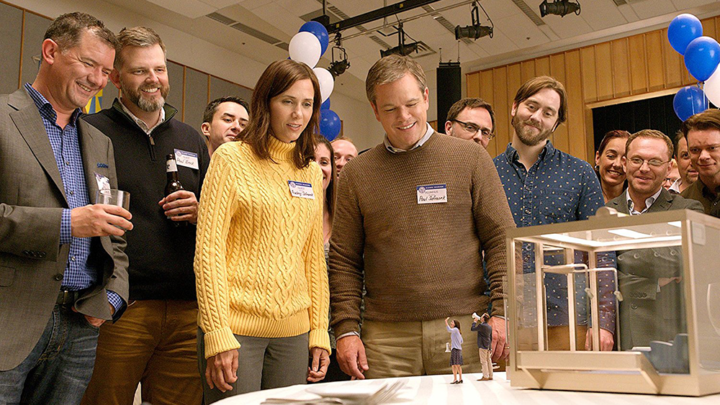
It’s rare I recommend a slice of American art house, but Downsizing is an example of how to make a thought-provoking, medium-budget Hollywood film about big themes without being too clunky or obvious or politically correct or po-faced.
First things first: It’s a pleasure to look at. It would have been so easy, in our era of convincing CGI, for a fable like this to adopt an exaggerated fairy-tale look—heaven only knows what grotesquerie someone like Tim Burton or Wes Anderson would have opted for. Yes, some kind of 1950s suburban golden glow seems to have been applied its palette, but the production and costume design, lighting, and technology is as realistic as it is stylish. Take it from a reformed lab rat, the setting of the opening Eureka! sequence is as close to an actual biomedical research lab as I’ve seen in a film since Contagion.
On the matter of technology, of course, another First Thing to be mention First is that there are good reasons—that would make a classic Oxbridge Entrance Exam question—why “cellular miniaturization” technology wouldn’t work; but this is science fiction, so (contrary to most SF-skeptics’ view of the genre) we have to take the premise as a given to get to the meat of the matter. And, to the makers’ credit, for the most part they do their best to depict the practical implications of implementing that technology, rather than skipping over them for narrative convenience.
Second things second: The quality of the performances of the principals is excellent throughout. One or two of the supporting cast members give the impression of not being professional actors, and that seems to have been a deliberate choice. An unusual quality of this film is that it shows workplaces in a way that is true to life; characters’ motivations centre around their feelings about their work in a way that is truer to real life than it is to most films. It’s ironic that the authentic delivery of lines by what seem to be real working people pulls you out of the movie’s world, when none of the main performances are actorly, but it does.
Now, to the substance: There’s not a great deal to this story. It hinges on its premise and perhaps three big choices by the protagonists. But you care about all those choices, especially the last. Not because the leads are heroic or accomplished or represent something bigger than themselves, or even because you identify with them; but because you come to appreciate their humanity. That alone makes a film worth a couple of hours of your time.
But the simple plotting bears a good load of quiet fun. There are fine, understated visual gags. There is social satire beyond the premise itself. There is physical humour that is perhaps the best small-scale slapstick since Mr Bean did that thing with the toy container lorry. (Watch out at the end for some brilliant work with a walk-on trolley bag.)
This is a (geo-)political satire, Damian, so what about the politics?
Again, to my surprise, this turned out to be one of the most interesting things about the film. The hi-tech eco-warriors who drive the story are presented in a (literal) flattering light (especially at the climax of the tale), but it’s no accident that they are also undercut throughout by other aspects of the presentation, in particular by the dismissive-but-seductive cynicism of Christoph Waltz’s character.
A standard “woke” thread runs throughout that “white people” are to blame for various ills and that, even in utopia, non-whites and immigrants inevitable victims; but there is also a Vietnamese character whose pidgin-English delivery borders on parody. What prevents this trope from being “problematic” is that hers is the voice of another three-dimensional human being. A film with two fully-realised people: one a believable man with believable motivations, and one a believable woman with believable motivations, is another rare thing. Even if you strip everything else away, there’s a world in that small achievement.

Recent Comments